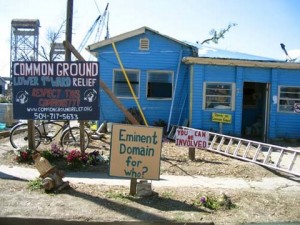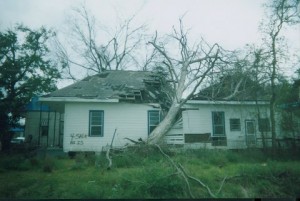For the first time since launching this blog, I have invited a guest author, Stephen D. Villavaso, a New Orleans native, urban planner, and land-use attorney, to comment on today’s tenth anniversary of Hurricane Katrina’s landfall on the Gulf Coast. I was heavily involved not only in the Shreveport conference he mentions below in October 2005, but also in the subsequent Louisiana Recovery and Rebuilding Conference in New Orleans the following month, and supplied Steve with the “boxes of books” to which he refers, which consisted of copies of APA’s 1998 report, Planning for Post-Disaster Recovery and Reconstruction, which he dutifully distributed to fellow professionals in the weeks that followed. I am happy to turn over this forum to Steve on this special occasion.
How Do We Set the Right Tone for an Anniversary, a Milestone….a Birthday??
by Stephen D. Villavaso, J.D., FAICP
Ten years seem like a long time to someone growing up, but not so long to mature elders watching and nurturing a new budding person. Some may even tire of the annual milestone review that seems to redundantly and almost imperceptibly move toward some unknown completion. Such may be the feelings people entertain as the ten-year milestone of the events centered on Hurricane Katrina arrives.
First, some myths need to be dissolved in favor of some clear starting points. Hurricane Katrina did “hit” on August 29, 2005. But more importantly, dozens – no, hundreds, possibly thousands –of events cascaded (and continue to cascade) from the moment of the so-called “hit.” Lives lost, homes destroyed, neighborhoods shattered, and cultures wrecked are but a few that should be marked in time and remembered. New beginnings, renewed faith, technology advancements, and new ideas and creativity should also be hallmarked and remembered. Remembered because “ten” is an important benchmark (a birthday?), some might say.
Katrina-fatigue was, and continues to be, discussed and experienced in many areas. In movies, songs, political speeches, product placement ads, and even in publishing, the Katrina-fatigue syndrome has caused many glazed eyes, bad reviews, and the occasional attack on the underlying motivations. Urban planners have not been immune to any of these phenomena surrounding Katrina. Within the first six hours of the “hit”, communications between planners at local, state, federal, and international levels exploded the airways.
 Ten years ago the “airways” were primitive as compared to the instant, high speed, always-connected cyberspace a mere decade later. To say that bandwidth was very restricted is a geeky way to say the phones just plain did not work very well. Flip phone texting was slow and unreliable, and most people did not even know how to do it. Land lines in the general vicinity of the hit (within 100 miles) were gone for the most part, and the few satellite phones in use almost never worked. The systems that did work were the existing professional and cultural networks that had been established prior to and nurtured since these events. Getting out of the impacted zone was a key step in linking communications out and then eventually back into the areas.
Ten years ago the “airways” were primitive as compared to the instant, high speed, always-connected cyberspace a mere decade later. To say that bandwidth was very restricted is a geeky way to say the phones just plain did not work very well. Flip phone texting was slow and unreliable, and most people did not even know how to do it. Land lines in the general vicinity of the hit (within 100 miles) were gone for the most part, and the few satellite phones in use almost never worked. The systems that did work were the existing professional and cultural networks that had been established prior to and nurtured since these events. Getting out of the impacted zone was a key step in linking communications out and then eventually back into the areas.
These exploded airways actually resulted in a sort of boundary of communication accessibility that existed around the most impacted areas. The mobilization of planning resources began in Shreveport, Louisiana, at the already scheduled October 2005 state conference of the Louisiana Chapter of the American Planning Association. This North Louisiana location was just far enough away from the impacted zone to allow for the dialogue and planning solutions to emerge. Ironically, the conference was almost cancelled due to incredible logistic issues (i.e., air service limitations and infrastructure failures). These hurdles were overcome with two other significant forces that also served to overcome the psychological roadblocks: the dogged local perseverance to recover and the sincere national commitment to assist. Thus, within 72 hours of the impact of Katrina, national and state APA leaders made the decision to stay the course and convene the state conference on schedule, albeit with a new, urgent focus. So now another point of remembrance is this unique gathering of the best and brightest planning minds that converged in Shreveport to begin the dialogue of replanning neighborhoods, restarting communities, recharging regions, and reconnecting these levels with the rest of the state and even the nation. These events that emerged from the early days after the hit have rocketed the field of what was called “disaster recovery” into the robust science of resilience planning and implementation mandates that serves city planners and decision makers a mere decade later.
Subsequent hurricanes (i.e., Rita, Gustave, Ike, Sandy, and others); inland riverine flooding in Kansas, Colorado, and other basins; almost regular earthquakes (followed by tsunamis) along the western U.S. fault zones; and the now cyclical drought/fire/landslide scenarios have continuously added chapters, techniques, and new policy initiatives and solutions to the planners’ resilient recovery toolbox.
A ten-year milestone is an important mark in an event’s history if it can teach or continue to teach. Teaching a community to be better prepared (to plan), of course, is fundamental, but for urban planners, the “teachable moment” never ends. The dozens of stories that should be documented on this anniversary will be told. These planning stories should be viewed through many lenses. One key focal point is the role of the American Planning Association (APA). APA landed in Shreveport ten years ago with the best minds on the planet, boxes of books, some meager funding sources, and an undaunted spirit to “build belter communities.” That moment continues, the remembrance is important, and the story needs to be told and retold.
Stephen D. Villavaso is a New Orleans native whose family has lived in New Orleans for 300 years. For the past forty years Steve has worked as an urban planner/professor/attorney, spending the last ten (post-Katrina) years rebuilding his home, city and state, in that order. See his full bio.


